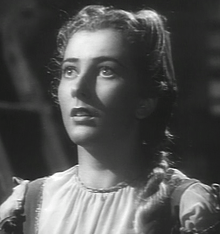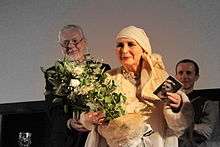Valentina Cortese
Valentina Cortese (1 January 1923 – 10 July 2019) was an Italian actress. She was nominated for the Academy Award for Best Supporting Actress for her performance in François Truffaut's Day for Night (1973).[1][2]
Valentina Cortese | |
|---|---|
 Cortese in The Jester's Supper (1942) | |
| Born | 1 January 1923 |
| Died | 10 July 2019 (aged 96) Milan, Lombardy, Italy |
| Other names | Valentina Cortesa |
| Occupation | Actress |
| Years active | 1941–1993 |
| Spouse(s) | |
| Children | Jackie Basehart |
Personal life
Cortese was born in Milan to a family from Stresa, Piedmont. In 1940, she met conductor Victor de Sabata who was 31 years older than her and married and with children. She left high school to follow him to Rome and there she graduated from the Academy of Dramatic Art. They separated in 1948.[3] Cortese married Richard Basehart, her co-star in The House on Telegraph Hill, in 1951, and had one son with him, the actor Jackie Basehart; they divorced in 1960. She never remarried.[4] Jackie Basehart died in Milan in 2015, predeceasing Cortese.
Cortese died on 10 July 2019, aged 96.[5]
Career

Cortese made her screen debut in Italian films in 1940, leading to her first internationally acclaimed roles in Riccardo Freda's 1948 Italian film Les Misérables with Gino Cervi and a very young Marcello Mastroianni, in which she played both Fantine and Cosette, and the 1949 British film The Glass Mountain (1949),[6] which led to a number of roles in American films of the period, but continued to make films in Europe with such directors as Michelangelo Antonioni, Federico Fellini and François Truffaut.[6][7]
She signed a contract with 20th Century Fox in 1948. She starred in Malaya (1949), a Second World War film about smuggling and guerrilla warfare against the Japanese with Spencer Tracy and James Stewart, Jules Dassin's Thieves' Highway (1949) with Richard Conte and Lee J. Cobb, The House on Telegraph Hill (1951) directed by Robert Wise and co-starring Richard Basehart and William Lundigan, and Joseph L. Mankiewicz's The Barefoot Contessa (1954), with Humphrey Bogart, Ava Gardner and Edmond O'Brien. In Europe she starred in Michelangelo Antonioni's Le Amiche (1955), Gérard Brach's The Boat on the Grass (1971), Terry Gilliam's British film The Adventures of Baron Munchausen (1988), and in Franco Zeffirelli projects such as the film Brother Sun, Sister Moon (1972), the miniseries Jesus of Nazareth (1977) and the film Sparrow (1993). Her final American film role was in When Time Ran Out (1980).[8]
Selected filmography
- L'orizzonte dipinto (1941)
- L'attore scomparso (1941)
- Il bravo di Venezia (1941) – Alina
- First Love (1941) – Nerina Redi
- Girl of the Golden West (1942) – Madge / Juanita
- The Jester's Supper (1942) – Lisabetta
- The Queen of Navarre (1942) – Eleonora d'Austria
- Soltanto un bacio (1942) – Maria Renda / Luisa Renda
- Orizzonte di sangue (1942) – Lidia
- Quarta pagina (1942) – Valentina, la sua segretaria
- Happy Days (1942) – Marianna
- 4 ragazze sognano (1943) – Enrichetta Dorlence
- La carica degli eroi (1943)
- Nessuno torna indietro (1945) – Valentina
- The Ten Commandments (1945) – (segment "Non nominare il nome di Dio invano")
- Chi l'ha visto? (1945) – Luisella
- Roma città libera (1946) – La ragazza
- A Yank in Rome (1946) – Maria, La maestrina
- Bullet for Stefano (1947) – Barbara
- The Courier of the King (1947) – Louise de Renal
- Les Misérables (1948) – Fantine and Cosette
- The Wandering Jew (1948) – Esther
- Crossroads of Passion (1948) – Maria Pilar
- The Glass Mountain (1949) – Alida
- Black Magic (1949) – Zoraida
- Thieves' Highway (1949) – Rica
- Malaya (1949) – Luana
- Women Without Names (1950) – Anna Petrovic the Jugoslav
- Shadow of the Eagle (1950) – Elizabeth, Princess Tarakanova
- The Rival of the Empress (1951) – Principessa Tarakanova
- The House on Telegraph Hill (1951) – Victoria Kowelska
- Secret People (1952) – Maria
- Lulu (1953) – Lulù
- Jealousy (1953) – Agrippina (voice, uncredited)
- The Walk (1953) – Lisa
- Angels of Darkness (1954) – Vally
- Marriage (1954) – Natalia Stefanovna Chubukova
- Avanzi di galera (1954) – Moglie di Luprandi
- The Barefoot Contessa (1954) – Eleanora Torlato-Favrini
- Adriana Lecouvreur (1955) – Adriana Lecouvreur
- Le Amiche (1955) – Nene
- Il conte Aquila (1955) – Teresa Casati
- Faccia da mascalzone (1956)
- Magic Fire (1956) – Mathilde Wesendonk
- The Rocket from Calabuch (1956) – Eloisa, the Schoolmistress
- Dimentica il mio passato (1957)
- Kean – Genio e sregolatezza (1957) – Fanny (uncredited)
- Amore a prima vista (1958)
- Love and Troubles (1958) – Marisa
- Square of Violence (1961) – Erica Bernardi
- Barabbas (1961) – Julia
- Axel Munthe, The Doctor of San Michele (1962) – Eleonora Duse
- The Girl Who Knew Too Much (1963) – Laura Craven-Torrani
- The Visit (1964) – Mathilda Miller
- The Possessed (1965) – Irma
- Juliet of the Spirits (1965) – Valentina
- Soleil noir (1966) – Maria
- The Legend of Lylah Clare (1968) – Countess Bozo Bedoni
- Listen, Let's Make Love (1968) – Lallo's Mother
- Oh, Grandmother's Dead (1968) – Ornella
- The Secret of Santa Vittoria (1969) – Gabriella (uncredited)
- Give Her the Moon (1970) – Madeleine de Lépine
- First Love (1970) – Mother
- The Love Mates (1970) – Eva
- The Boat on the Grass (1971) – Christine
- The Iguana with the Tongue of Fire (1971) – Mrs. Sobiesky
- Chronicle of a Homicide (1972) – Luisa Sola
- Brother Sun, Sister Moon (1972) – Pica Di Bernardone
- The Assassination of Trotsky (1972) – Natalia Sedowa Trotsky
- Day for Night (1973) – Séverine
- Appassionata (1974) – Elisa Rutelli
- Tendre Dracula (1974) – (uncredited)
- The Kiss of Death (1974) – Elizabeth Blixen
- Amore mio non farmi male (1974) – Sabina Foschini
- Dracula in the Provinces (1975) – Olghina Franchetti
- Kidnap Syndicate (1975) – Grazia Filippini
- Son tornate a fiorire le rose (1975) – Sabina Foschini
- Nick the Sting (1976) – Regina – Nick's Mother
- The Big Operator (1976) – The Widow
- Jesus of Nazareth (1977, TV Mini-Series) – Herodias
- Nido de viudas (1977) – Dolores
- Tanto va la gatta al lardo... (1978) – Vilma / Leonilde Bosco Casagrande
- Un'ombra nell'ombra (1979) – Elena Merrill
- When Time Ran Out (1980) – Rose Valdez
- La ferdinanda: Sonate für eine Medici-Villa (1982) – Caterina de Dominicis
- Via Montenapoleone (1987) – Madre di Guido
- Tango blu (1987) – Rachele Cigno
- Young Toscanini (1988) – Comparsa (uncredited)
- The Adventures of Baron Munchausen (1988) – Queen Ariadne / Violet
- Buster's Bedroom (1991) – Serafina Tannenbaum
- Sparrow (1993) – Mother Superior (final film role)
References
- "The 47th Academy Awards (1975) Nominees and Winners". Academy of Motion Picture Arts and Sciences. Retrieved 14 May 2011.
- Bergan, Ronald; Lane, John Francis (10 July 2019). "Valentina Cortese obituary". The Guardian. ISSN 0261-3077. Retrieved 14 July 2019.
- "È morta Valentina Cortese, la gran dama del cinema dal foulard perenne" by Debora Attanasio, Marie Claire, 10 July 2019 (in Italian)
- Profile, gramilano.com; accessed 21 May 2015.
- Addio Valentina Cortese, l'ultima diva
- IMDb profile
- Antonio Gnoli (18 May 2014). "Cortese: 'La mia avventura a Hollywood finì con un whisky in faccia al re della Fox' ". La Repubblica (in Italian). Retrieved 9 January 2020.
- Maurizio Porro (2 April 2012). "Cortese: i foulard, l'amore e la mia bimba mai nata". Corriere della Sera (in Italian). Retrieved 9 January 2020.
External links

- Valentina Cortese on IMDb